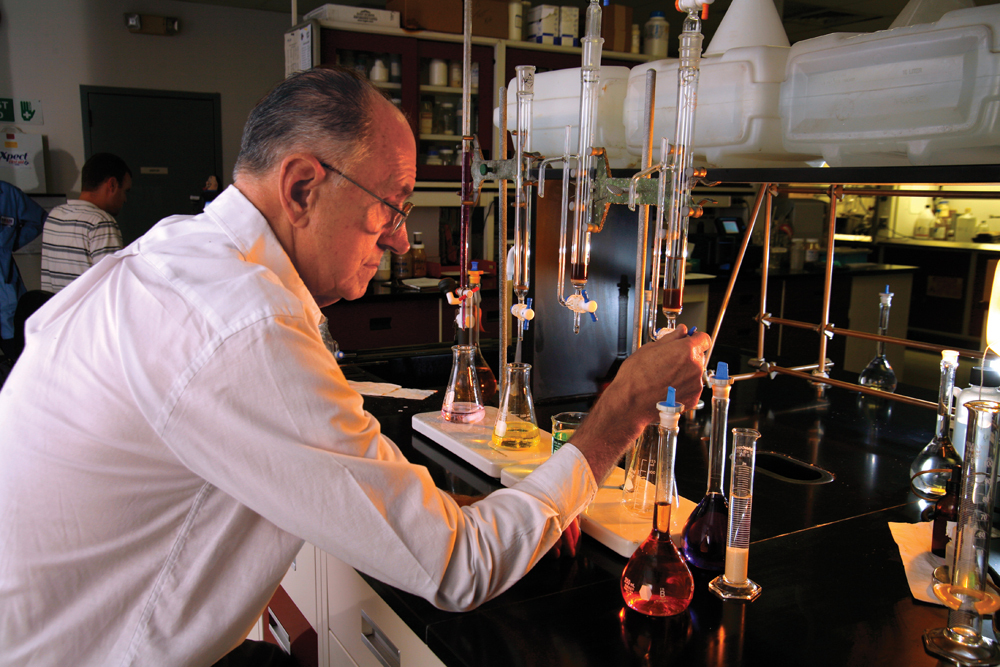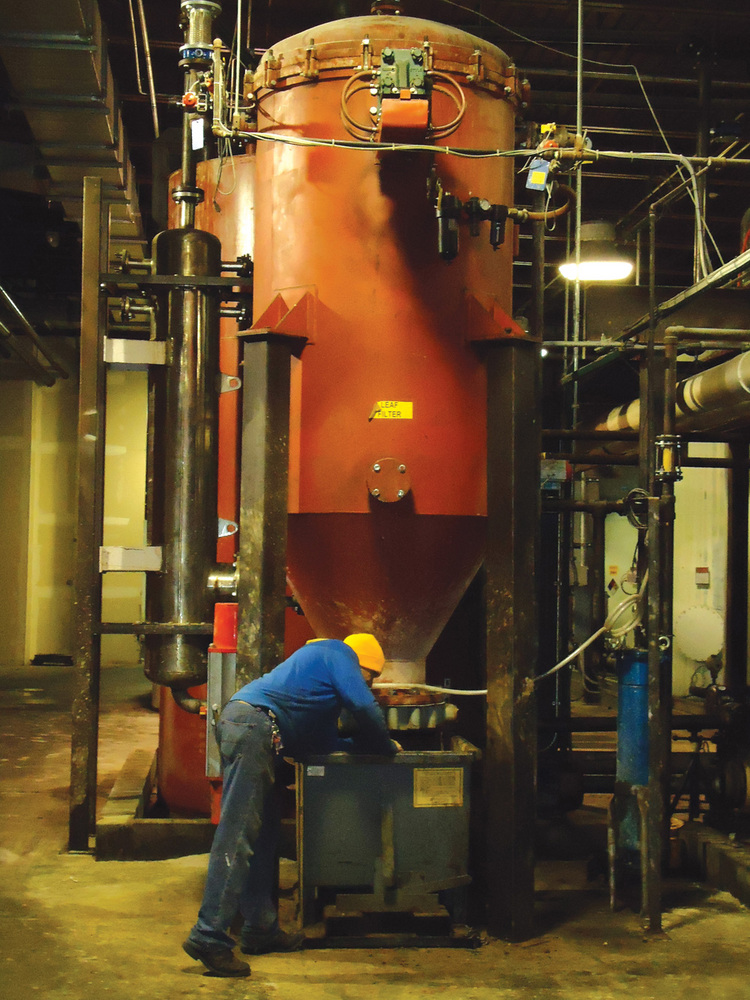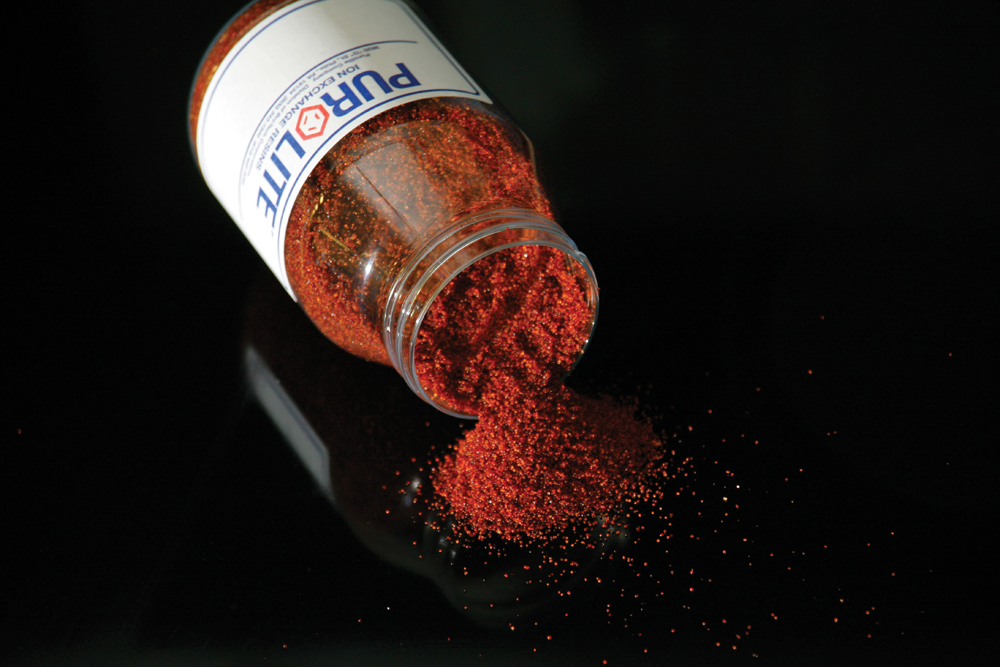Finding the Right Purification Approach




PHOTO: PUROLITE
March 9, 2011
BY Bryan Sims
When it comes to biodiesel production, quality is the name of the game. For biodiesel producers, that means finding the most economically viable and efficient purification equipment capable of filtering out excess impurities such as glycerin, sulfur, soaps, methanol and other trace contaminants commonly found in their methyl esters in order to meet stringent ASTM D6751 specifications. Overlooking this step can result in producing off-spec product, translating into lost production time that ultimately cuts into the bottom line.
One of the most commonly used methods for purifying biodiesel is to wash the impurities out with water. Other effective, though archaic, ways to wash biodiesel are agitation, mist and bubble washing. Water has a very low affinity for biodiesel and absorbs excess alcohol, catalyst and soap suspended in the fuel. After the biodiesel is washed, it has to be dried. This is usually done via vacuum flash drying with an evaporator, or it can dry when left in settling tanks. Spent process water can be pretreated for evaporation or sent to a distillation column to be recycled in the process. Water that isn’t recycled is discharged as effluent to sewer systems.
Most water washing systems are utilized by larger-scale production plants—usually 15 MMgy or more. Typically, this process will use approximately 10 percent (volume basis) wash water in multiple countercurrent washes to clean the biodiesel. During the process, the cleanest wash water is introduced into the cleanest biodiesel; the dirtiest wash water is introduced into the dirtiest biodiesel and the two streams flow in opposite directions.
But water washing has its drawbacks. It’s a time-consuming step that requires many hours for the biodiesel and water to completely separate. And, since virtually all biodiesel processes use a homogeneous catalyst like sodium or potassium methoxide, the presence of soap can create emulsification problems, which impair the separation of the water and biodiesel during the wash, according to Will Smith, engineering manager for Salem, Ore.-based Pacific Biodiesel Technologies Inc. Since 2000, PBT has provided engineering, equipment, contracting and laboratory services for 10 biodiesel plants in the U.S. The company is credited with building the first commercial-scale production facility in the country, a 1.5 MMgy facility in Kahului, Hawaii, owned and operated by Pacific Biodiesel Inc.
“One thing that gets people hung up is that [water washing] doesn’t do a good job of removing trace contaminants like phosphatides and sterols, which are things that tend to precipitate out of biodiesel in storage and downstream handling,” Smith tells Biodiesel Magazine. “A recycle water wash approach is well-suited for plants that are running a pretty uniform feedstock where their soap concentrations are relatively constant and don’t require a whole lot of water to do the purification.”
In addition to phosphatides and sterols, sulphur compounds are another class of contaminants that are not effectively removed via a water wash system according to Ashley Player, chemical engineer at Frazier, Barnes & Associates. “Typically not present in virgin oils, or present in only very small amounts, these materials are a significant contaminant in many secondary feedstocks like poultry fats and some tallows and greases,” Player says. Too much sulfur content can be problematic if specified sulfur levels aren’t at 15 ppm per the on-road diesel specification.
Water washing is well-suited if the biodiesel has low soap concentrations that prevent emulsification. This was the method preferred by many producers during the industry’s growth period that began in 2006, according to Rahul Bobbili, vice president of Miamisburg, Ohio-based biodiesel producer and technology provider Jatrodiesel Inc. “During the build-out of the biodiesel industry, whoever was using virgin feedstocks with FFA content less than 0.5 percent, they were all doing water washing while encountering no issues,” Bobbili says. “But, as soon as the high FFA feedstocks started coming into the market, animal fats, used cooking oil and so forth with FFAs ranging between 0.5 and 20 percent, then water washing became a hassle because the soap quantities increased, as well as sulfur and other impurity levels.”
Advertisement
Because the introduction of water increases the risk of emulsification, dry washing alternatives are proving to be more effective, primarily within the smaller-scale class of producers.
Dry Wash Alternatives
In dry washing, an absorbent is added that adheres to and combines with impurities, separating them from the biodiesel. Some systems use ion exchange resins as the absorbent while others may use a fine magnesium silicate powder, several of which are marketed under well-known brand names such as Magnesol by the Dallas Group of America Inc. and Select by Oil-Dri, to name a few.
The use of magnesium silicate absorbents involves pouring the material into the unpurified biodiesel, mixing the two together and then filtering out the remaining impurities with various membranes and filter media. Methanol is removed via evaporation prior to coming in contact with the absorbent because of its high polarity. According to Smith, this approach also works well for plants that have varying levels of soap and free glycerin, especially in batch process plants.
“It also does a great job of removing primary contaminants, residual catalysts and methanol,” Smith says. “It’s also effective in removing trace compounds like sulfur, phosphatides and intermediate decomposition products commonly found in used cooking oils that have been left in fryers for extended periods of time.”
Ion exchange, or active filtration, involves the use of resin that’s typically placed inside a vessel forming a packed bed where the methyl ester stream passes through it. Any free glycerin in the stream will attach to the surface of the resin. Catalyst and soap are removed from the biodiesel by the exchange of ions between the resin and the contaminants. In the case of residual catalyst, such as sodium methoxide, the resin exchanges a hydrogen ion for a sodium ion. Similarly, a hydrogen ion is exchanged for a sodium ion of a soap molecule to form an FFA. Because of this exchange, the technique is only effective for soap levels up to approximately 2,500 ppm. If soap levels are above this threshold, increased levels of FFAs can result in an acid number that exceeds ASTM specifications.
As with water wash systems, ion exchange approaches have disadvantages because the resins depreciate during each purification cycle. Although the resin can be regenerated to remove glycerin, they cannot be regenerated to remove soap. The expediency at which they can be regenerated to complete each cycle varies by supplier, according to Bobbili.
“You can regenerate the resin, but, for example, the first time you buy the resin it may perform 100 days,” Bobbili says. “After regeneration, it may perform 90 days and after that, 80 days, so the consumption trends smaller and smaller.”
Advertisement
Center Alternative Energy Co., a 5 MMgy plant in Cleveland, Ohio, uses a resin manufactured by Purolite. According to General Manager Bill Dummermuth, limited soap content in the biodiesel can increase the life of the resin. “If you’re doing a good job in decanting, the resin will last a very long time,” Dummermuth says. “The material that we’re currently using typically lasts about 350,000 gallons. I think the number resin companies tout is around 100 gallons of biodiesel per pound of resin. I’ve gotten about 80 percent of that in my system.”
How much biodiesel resin can handle before it’s spent depends on guarantees by the resin supplier. For Purolite, about one pound of PD206 resin product can treat between 200 and 250 gallons of B100, which translates into approximately 35 to 50 cents per gallon of B100 operating cost, the company stated in e-mail correspondence with Biodiesel Magazine.
Trending Towards Reliability
Like process technology, the industry has seen an evolution of purification equipment enter the market over the years. As improvements to existing purification technologies continue, the type of feedstock introduced can also greatly impact biodiesel quality, irrespective of the type of the purification equipment used, according to Smith. “The purification part of the biodiesel production process is really only as good as the product that’s fed into it,” Smith says.
Smith adds that PBT is developing a vacuum distillation technology for biodiesel purification to be installed at Pacific Biodiesel’s 5 MMgy multifeedstock plant currently under construction on the Big Island of Hawaii. The goal, he says, is to leave sulfur-containing compounds, polymerized compounds and other unreacted materials, ending up with a crystal clear product.
“It’s a robust technology where you have a lot of control over the separation, and you don’t have any consumables like resins and silicate absorbents so it helps a lot from an operating cost standpoint,” Smith says. “You just have to worry about energy input.”
Player says that FBA has gotten more interest in dry wash systems, “but the problem is that it’s cost-prohibitive,” she says.
For Jatrodiesel, Bobbili is seeing a trend of plants with an installed capacity of 10 to 15 MMgy or below moving towards ion exchange or clear filtration (silicate absorbent) purification methods with plants exceeding that level typically utilizing water wash systems. “Whenever we propose plants at the 10 to 15 MMgy range, we propose clear filtration systems because quality is our biggest push,” Bobbili says. “Quality is key in the biodiesel industry. We want to stick to something that is reliable.”
Author: Bryan Sims
Associate Editor, Biodiesel Magazine
(701) 738-4974
bsims@bbiinternational.com
Upcoming Events





